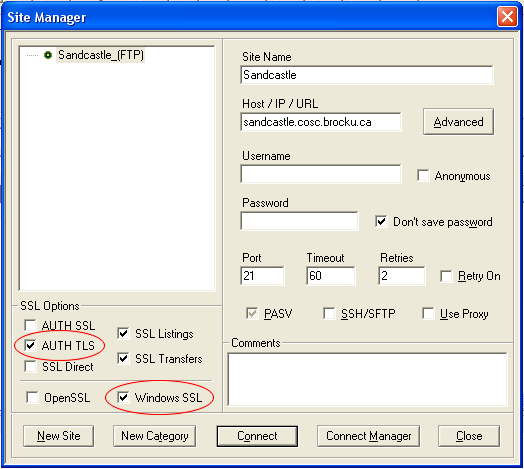

The server will need the "Allow key authentication" option checked in the domain setup.įor SSH key pairs and no account password, the "Key authentication only" option should be checked. Select the public key file in the Core FTP Server's user "security properties", in the "ssh pub cert" field. Putty users using psftp need to export OpenSSH public keys using PuttygenĮntering public key into Core FTP Server Once you have created a key pair, the public key file is then placed in a directory on the server that cannot be accessed by the client account. Ssh-keygen usage: (Unix/Linux) rsa keys: ssh-keygen -tįor Unix/Linux, dsa keys may be the preferred method due to better compatibility across operating systems.
#Coreftp server ssh shell password
Step 3: Selecting private key into client site profileĪdditionally if no account password is being used for the server, check the Advanced -> General -> "Don't prompt for password when empty" option. Key pairs are typically created by the client, and then the resulting public key is used by Core FTP Server.Ĭore FTP products use the OpenSSH SSH2 format, that can be generated using Core FTP software, or via the ssh-keygen utility.Ĭore FTP client - creating a key pair Step 1: Advanced site settings -> ssh And thanks so much again! Wireshark-Screenshot-II.SSH key pairs allow an additional level of security that can be used in conjunction with the SFTP protocol.
#Coreftp server ssh shell how to
I am not sure on how to allow access to the network through the firewall for port 989-990 when it apprears to me that it's already allowed. Reading back over your last post, I am not totally clear on what the provider is doing insofar as SecureFTP versus FTP over SSL, but it appears to me that they are setting-up a TLS session for the purposes of FTP, so that looks like FTP over SSL (the "new" SSL). However, the seond half of this process is breaking down. A secure TLS session is established for the purposes of authentication, or in this instance, the issuing of a certificate. I cannot identify anything in the configuration that would be blocking the establishment of a certificated session.Īgain, here's what I believe is happening.
#Coreftp server ssh shell Pc
It shows the whole of the SSL connection attempt from a PC on my private network (192.x.x.x) to the server on the remote network (134.x.x.x).


Sorry for pasting SSH information that is not relevant to my question at all. However, there is absolutely NO outside access to the routers or firewall, and all inside access is via SSH no telnet or http whatsoever. Then test the connection, and take wireshark capture and you will see the encrypted traffic If you still have traffic getting blocked, then open up access lists for ports 989 and 990 using the access-list syntax above The have the appropriate inbound access-lists for allowing ssh traffic for this server:Īccess-list outside_inside permit tcp any host eq 22Īpply the access list to the outside interface:Īccess-group outside_in in interface outside Second, make sure you are using static NAT if you have a seperate public ip for this server: Verify which type of secure FTP you are y using - Secure FTP is often confused with "FTP over SSL".įirst, coreFTP operates with ssh on port 22 : If port 990 isn't open or if the server isn't listening on the correct return port, it will fail Secure FTP initiates a connection on TCP port 990 then expects return data on a TCP high port, usually port 10021 or 10121. ssh is an encryption protocol used with certain secure ftp servers, but the above commmands you have are not associating traffic with the ftp server You are confusing ssh (secure shell) with secure ftp. Your wireshark capture indicates it is opening ftp connection over port 21 -ftp, not secure ftp


 0 kommentar(er)
0 kommentar(er)
